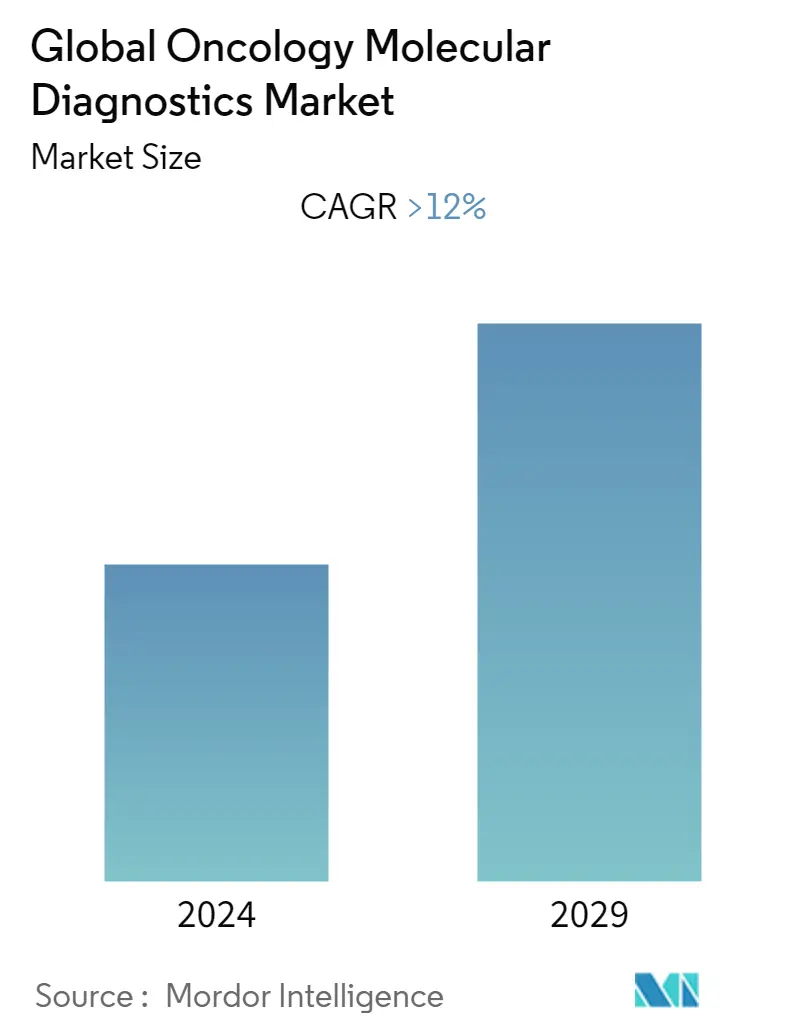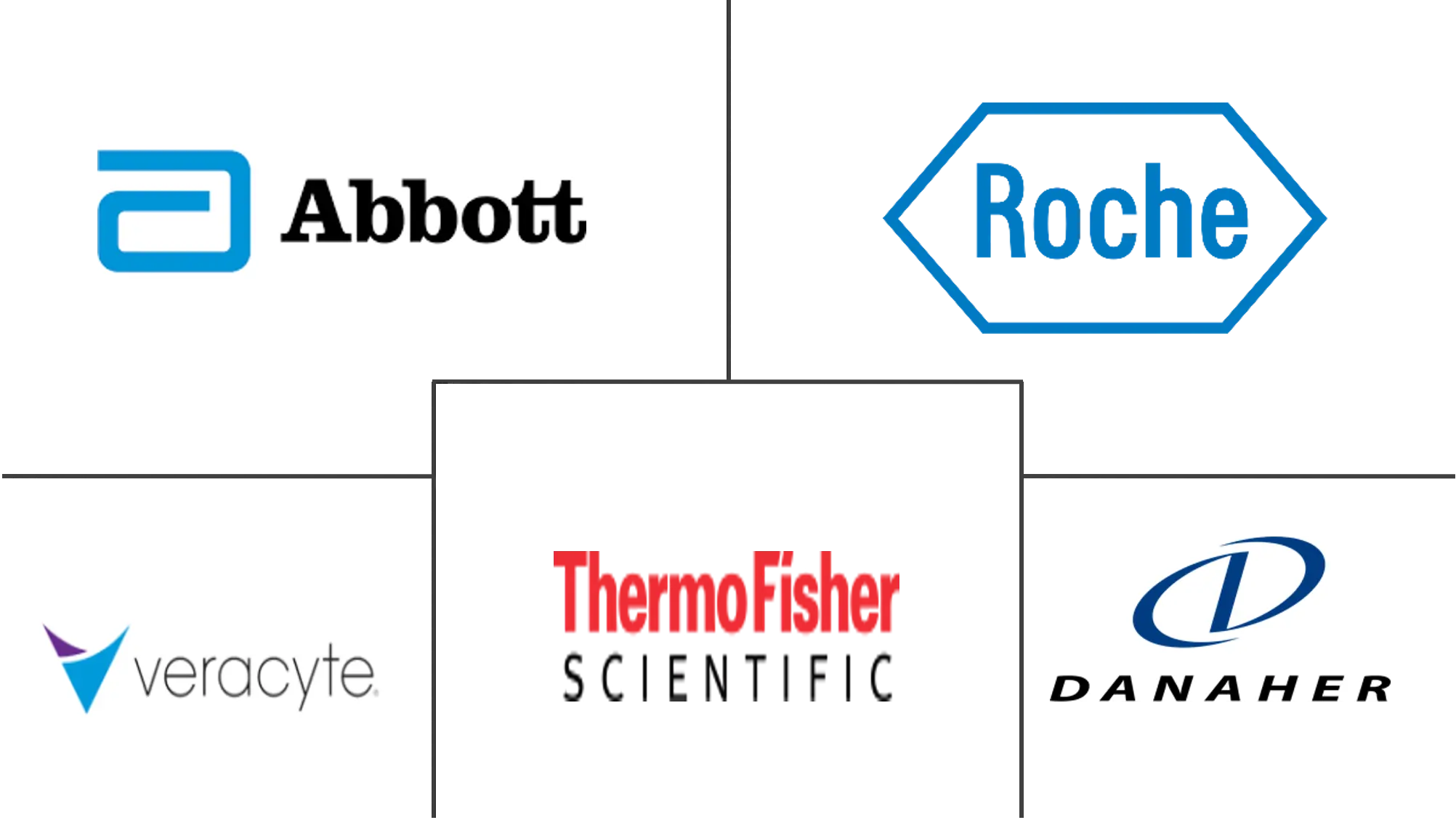Market Size of Global Oncology Molecular Diagnostics Industry

| Study Period | 2019 - 2029 |
| Base Year For Estimation | 2023 |
| CAGR | 12.00 % |
| Fastest Growing Market | Asia-Pacific |
| Largest Market | North America |
| Market Concentration | High |
Major Players
*Disclaimer: Major Players sorted in no particular order |
Oncology Molecular Diagnostics Market Analysis
The oncology molecular diagnostics market is expected to register a CAGR of more than 12 % during the forecast period.
The COVID-19 pandemic has significantly impacted the oncology molecular diagnostics market. As per the Association for Molecular Pathology (AMP), 2021 survey of 163 laboratories, worldwide, 85% of the respondents reported that molecular testing for cancer decreased during April-June 2020. Additionally, more than half of respondents revealed that oncology testing for clinical trials decreased due to lower enrollment, reluctance to travel, and the ability to perform testing. The survey results also indicate that the pandemic may continue to have long-term effects on molecular diagnostic testing for cancer. Additionally, laboratories and universities engaged in the R&D of cancer have witnessed a halt in activities across the world. Moreover, the government funding from various organizations for the research is on hold in several regions of the world.
The growth of the market studied can be largely attributed to the factors, such as the rising prevalence of cancer, worldwide, technological advancements in diagnostic testing, and increasing demand for point-of-care testing. These factors are leading to increasing demand for oncology molecular diagnostics.
The rising prevalence of cancer cases across the world is contributing to the increasing demand for diagnosis, which is boosting the oncology molecular diagnostics market. According to the World Health Organization (WHO), cancer accounted for approximately 10 million deaths in 2020. Additionally, as per the 2021 statistics by the American Cancer Society, by 2040, the global burden of cancer is expected to grow to 27.5 million new cases and 16.3 million cancer deaths. Such high numbers indicate that the estimated rising prevalence of cancer is contributing to the increasing need for early diagnosis and preventive medicine. Thus, in view of the factors mentioned above, the demand for oncology molecular diagnostic tests is consistently increasing.
Additionally, due to the increasing technological advancements in diagnostic testing, there is a growing usage of molecular diagnostics tests for oncology. Several advancements are being made in cancer genome sequencing, computational analysis, tumor models, and innovative cancer research methods. For instance, Roche Molecular Systems, Inc. developed Cobas EGFR Mutation Test for non-small cell lung cancer patients and received approval from the United States Food and Drug Administration (USFDA) in 2020 and is a real-time PCR test to detect 42 mutations of the epidermal growth factor receptor (EGFR) gene. Moreover, in March 2021, Cancer Research UK and Capital Enterprises and Roche UK together launched the Cancer Tech Accelerator program. The new initiative may aid researchers in translating their ideas and lifesaving innovations. Thus, in view of the factors mentioned above, the market is anticipated to witness significant growth over the forecast period.
However, the high cost of molecular diagnostic tests, lack of skilled workforce, and stringent regulatory framework are some of the factors impeding the market growth.
Oncology Molecular Diagnostics Industry Segmentation
As per the scope of the report, oncology molecular diagnostics are tests that detect genetic material, proteins, or related molecules that provide cancer information. The market consists of sales of molecular diagnostic instruments, kits, and reagents for diagnosing cancer. The market is segmented by product type (instrument, reagents, and other product types), technology type (polymerase chain reaction (PCR), isothermal nucleic acid amplification technology (INAAT), DNA sequencing and next-generation sequencing, in situ hybridization, mass spectrometry, transcription-mediated amplification (TMA), chips and microarrays, and other technology types), application type (breast cancer, prostate cancer, colorectal cancer, lung cancer, blood cancer, liver cancer, cervical cancer, and other application types), end user (hospitals, diagnostic centers, and other end users), and geography (North America, Europe, Asia Pacific, Middle-East and Africa, and South America). The market report also covers the estimated market sizes and trends for 17 different countries across major regions, globally. The report offers the value (in USD million) for the above segments.
| By Product Type | |
| Instrument | |
| Reagents | |
| Other Product Types |
| By Technology Type | |
| Polymerase Chain Reaction (PCR) | |
| Isothermal Nucleic Acid Amplification Technology (INAAT) | |
| DNA Sequencing and Next-Generation Sequencing | |
| In-situ Hybridization | |
| Mass Spectrometry | |
| Transcription Mediated Amplification (TMA) | |
| Chips and Microarrays | |
| Other Technology Types |
| By Application Type | |
| Breast Cancer | |
| Prostate Cancer | |
| Colorectal Cancer | |
| Lung Cancer | |
| Blood Cancer | |
| Liver Cancer | |
| Cervical Cancer | |
| Other Application Types |
| By End User | |
| Hospitals | |
| Diagnostic Centers | |
| Other End Users |
| By Geography | ||||||||
| ||||||||
| ||||||||
| ||||||||
| ||||||||
|
Global Oncology Molecular Diagnostics Market Size Summary
The oncology molecular diagnostics market is poised for substantial growth, driven by the increasing prevalence of cancer globally and advancements in diagnostic technologies. The demand for early diagnosis and preventive medicine is rising, fueled by the growing number of cancer cases and the need for effective screening methods. Technological innovations, such as cancer genome sequencing and tumor models, are enhancing the capabilities of molecular diagnostics, making them more precise and efficient. The development of advanced tests, like Roche Molecular Systems' Cobas EGFR Mutation Test, underscores the industry's commitment to improving cancer detection and treatment. Despite challenges such as high costs and regulatory hurdles, the market is expected to expand significantly, with polymerase chain reaction (PCR) technology leading the way due to its sensitivity and rapid analysis capabilities.
North America, particularly the United States, holds a significant share of the oncology molecular diagnostics market, supported by a robust healthcare infrastructure and a high prevalence of cancer. The region benefits from the presence of numerous market players and established diagnostic facilities, which contribute to the development and adoption of innovative testing solutions. Collaborative efforts among key industry players, such as Veracyte Inc. and Bayer AG, aim to advance precision oncology through strategic partnerships and product innovations. These collaborations are expected to enhance the market's growth trajectory by facilitating the development of cutting-edge diagnostic tests and expanding their application in cancer treatment. As the market continues to evolve, the focus on integrating advanced technologies and fostering strategic alliances will be crucial in addressing the growing demand for molecular diagnostics in oncology.
Global Oncology Molecular Diagnostics Market Size - Table of Contents
-
1. MARKET DYNAMICS
-
1.1 Market Overview
-
1.2 Market Drivers
-
1.2.1 Rising Prevalence of Cancer Worldwide
-
1.2.2 Technological Advancements in Diagnostic Testing
-
1.2.3 Increasing Demand for Point-of-care Treatment
-
-
1.3 Market Restraints
-
1.3.1 High Cost of Molecular Diagnostic Tests
-
1.3.2 Lack of Skilled Workforce and Stringent Regulatory Framework
-
-
1.4 Industry Attractiveness - Porter's Five Forces Analysis
-
1.4.1 Bargaining Power of Buyers/Consumers
-
1.4.2 Bargaining Power of Suppliers
-
1.4.3 Threat of New Entrants
-
1.4.4 Threat of Substitute Products
-
1.4.5 Intensity of Competitive Rivalry
-
-
-
2. MARKET SEGMENTATION
-
2.1 By Product Type
-
2.1.1 Instrument
-
2.1.2 Reagents
-
2.1.3 Other Product Types
-
-
2.2 By Technology Type
-
2.2.1 Polymerase Chain Reaction (PCR)
-
2.2.2 Isothermal Nucleic Acid Amplification Technology (INAAT)
-
2.2.3 DNA Sequencing and Next-Generation Sequencing
-
2.2.4 In-situ Hybridization
-
2.2.5 Mass Spectrometry
-
2.2.6 Transcription Mediated Amplification (TMA)
-
2.2.7 Chips and Microarrays
-
2.2.8 Other Technology Types
-
-
2.3 By Application Type
-
2.3.1 Breast Cancer
-
2.3.2 Prostate Cancer
-
2.3.3 Colorectal Cancer
-
2.3.4 Lung Cancer
-
2.3.5 Blood Cancer
-
2.3.6 Liver Cancer
-
2.3.7 Cervical Cancer
-
2.3.8 Other Application Types
-
-
2.4 By End User
-
2.4.1 Hospitals
-
2.4.2 Diagnostic Centers
-
2.4.3 Other End Users
-
-
2.5 By Geography
-
2.5.1 North America
-
2.5.1.1 United States
-
2.5.1.2 Canada
-
2.5.1.3 Mexico
-
-
2.5.2 Europe
-
2.5.2.1 Germany
-
2.5.2.2 United Kingdom
-
2.5.2.3 France
-
2.5.2.4 Italy
-
2.5.2.5 Spain
-
2.5.2.6 Rest of Europe
-
-
2.5.3 Asia Pacific
-
2.5.3.1 China
-
2.5.3.2 Japan
-
2.5.3.3 India
-
2.5.3.4 Australia
-
2.5.3.5 South Korea
-
2.5.3.6 Rest of Asia Pacific
-
-
2.5.4 Middle East and Africa
-
2.5.4.1 GCC
-
2.5.4.2 South Africa
-
2.5.4.3 Rest of Middle-East and Africa
-
-
2.5.5 South America
-
2.5.5.1 Brazil
-
2.5.5.2 Argentina
-
2.5.5.3 Rest of South America
-
-
-
Global Oncology Molecular Diagnostics Market Size FAQs
What is the current Global Oncology Molecular Diagnostics Market size?
The Global Oncology Molecular Diagnostics Market is projected to register a CAGR of greater than 12% during the forecast period (2024-2029)
Who are the key players in Global Oncology Molecular Diagnostics Market?
Abbott Laboratories, F-Hoffmann La-Roche Ltd, Thermo Fisher Scientific Inc., Danaher Corporation (Cepheid) and Veracyte Inc. are the major companies operating in the Global Oncology Molecular Diagnostics Market.

